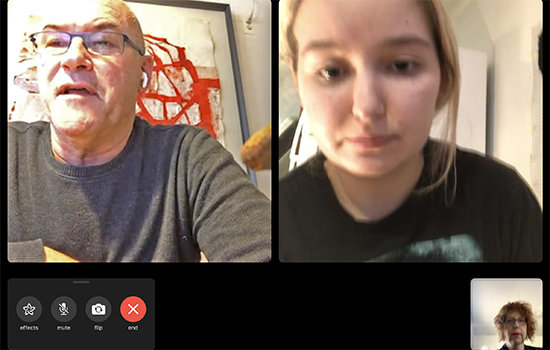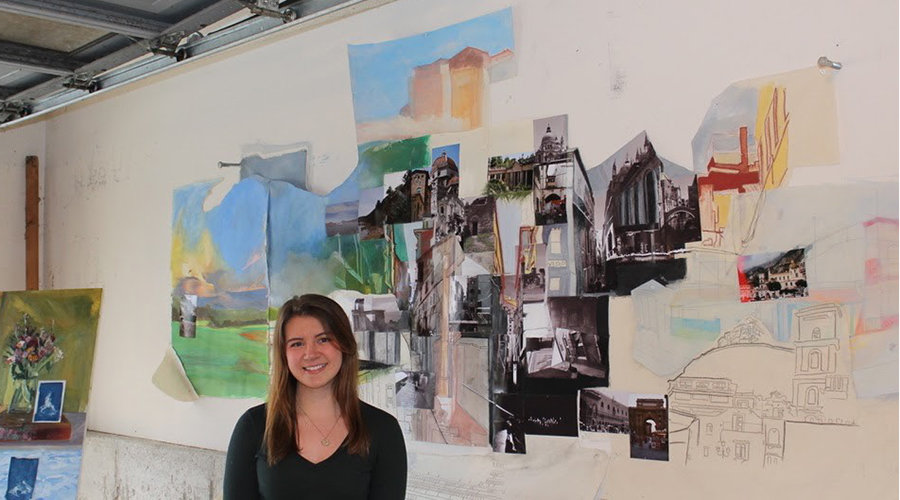On the other end of the conversation is Professor Audrey Goldstein, offering a critique from Boston.
Her professor guides Tourtellotte to a certain area of the collage and suggests a change in the sort of one-on-one interaction that has become familiar to Suffolk art students.
With remote learning replacing face-to-face education across the country during the COVID-19 pandemic, educators are constantly innovating. Studio art classes would seem to present a particular challenge; yet professors like Goldstein are sharing and implementing ideas for maintaining a vibrant educational experience for student artists.
When the move to remote learning began, one of the first things Goldstein did as chair of Suffolk’s Art & Design Department was to arrange a Zoom meeting with her faculty, with each professor reporting on what they were seeing as students adjusted to the new mode of learning.
She also tuned in to Facebooks group discussions with art professors and administrators nationwide.

“These have been a lifeline,” says Goldstein. “There are ideas for how to teach drawing, painting…ceramics when no kiln is available. It’s very heartening. I know many faculty have been on the sites.”
Home studio tips
One of Goldstein’s immediate concerns when students left behind the fully equipped studio facilities on campus was how they would create efficient, safe, and economical off-campus studios. So she wrote up home studio guidelines and distributed them to all students.“What do they do with paint water at home; you can’t wash it down the drain. We have hazardous waste removal at school,” says Goldstein. “Some are working on beds, the largest space they have available to them. If they’re working with pastels, they need to put plastic over the bed or they’ll be sleeping on pastel dust, which is bad for the lungs.”
“Luckily I can use my garage, which wouldn’t have been possible a year ago,” says Tourtellotte. As it happens, her family recently had deep-cleaned the garage.
Staying connected
Goldstein holds one-hour meetings with students at the beginning of the day and then spends 20 to 40 minutes with each student in meetings that run throughout the afternoon. “The faculty are all spending a lot of time with students this way,” she says.
But Goldstein noticed early on that the shared class time remains important. During the initial online classes that followed spring break “my students looked incredibly relieved to be looking at each other’s faces on the screen. They missed each other,” she says.
She recently began experimenting with having students in her Painting class draw from the Zoom screen.
“We drew for over an hour and it actually felt as close to the classroom experience as possible. I’m going to continue doing this for the remainder of the semester. Afterwards I do the FaceTime individual crits.”
Chat rooms and messaging groups also help students connect, and they are sharing studio photos and videos to track one another’s progress, says Tourtellotte. “We ask: ‘What do you think about this?’ In group meetings we talk about each student’s work.”
She says she’s trying to have a positive attitude despite the dramatic adjustments made as her college career nears its end.
“Everyone in my class having a tough time accepting this,” says Tourtellotte. “In a way that’s very helpful to see; I’m not the only one stressed. Everyone is taking it seriously.”
Ideas for student exhibits
A major concern addressed in the Facebook art administrators discussion group is the loss of the year-end exhibits that showcase student thesis work. One idea: having citywide senior shows in the fall.
“What I’d like to see is all the colleges in Boston joining together for one show,” says Goldstein, who has reached out to in other Boston-area college and university art programs to explore this option.
“The senior thesis show is something we’ve been working toward for four years,” says Tourtellotte. Preparations include “creating booklets, coming up with a title—everything that goes into a gallery show. We are all trying to figure out alternative ways to make it happen.”
It’s a collaborative effort, and the students value Zoom classroom sessions that enable them to plan the gallery show they hope will become reality.
“We’re pretending we are going ahead with the exhibit in May, just so we will get the work done,” says Tourtellotte, who notes that Goldstein, Professor Randal Thurston, his wife Alyson Schultz, and others are coming up with ideas to make the exhibit a reality, perhaps online or when normal activities resume. “Everyone is working together. The teamwork is really awesome.”
Contact
Greg Gatlin
Office of Public Affairs
617-573-8428




